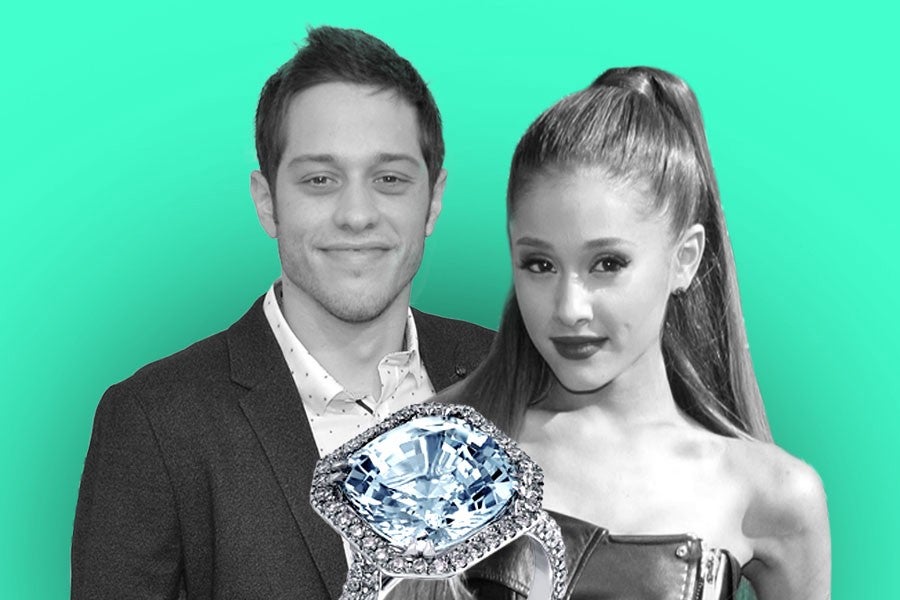Saturday Night Live star Pete Davidson is set to join the growing number of men marrying up after he and international pop superstar Ariana Grande publicly confirmed their engagement earlier this week — after just a month of dating.
Congrats to the lovely couple!
Now let’s talk about how capitalist goons manipulate male insecurity to sell blood diamonds and sink working families into further debt and misery.
Ignore that these celebrity power-couple arrangements always seem like cynical PR ploys. Or how I had junior high “relationships” that lasted longer than Grande and Davidson’s courtship. Instead, focus on the engagement ring Davidson bought Grande, which reportedly cost an astounding $93,000. That’s double the median household income in many states.
Perhaps it’s unfair to compare the lives of the über-famous to those of the ordinary citizen, and point out that Grande’s rock is double what many families pull in in a year. It’s still a glaring example of the divide between our nation’s haves and have-nots, and the increasing concentration of wealth at the uppermost stratum of society.
It also perfectly encapsulates what a wretched, soulless racket the engagement ring industry (and the entire wedding-industrial complex) is; how susceptible to advertising we are; and how persistent certain patriarchal rituals can be, even in the face of social progress.
Before we get to that, though, let’s break down the economics of Davidson’s purchase.
Who Can Afford a $100,000 Ring?
- The standard rule for buying an engagement ring is that it should cost two to three months’ worth of your salary (depending on whom you ask). More on that later.
- Supposing a groom-to-be adheres to the three-month rule, and that he pays an effective tax rate of 30 percent, he’d have to make $44,285.71 a month, or just less than $531,428.57 a year before taxes.
- It’s unclear what Davidson makes a year; SNL cast members are said to earn up to $24,000 per show, though senior members are reportedly better paid. Hypothetically, if he earns about $300,000 to 400,000 annually, the ring is still an extreme splurge — about a third of his pretax income.
Then again, it’s not that ridiculous when you consider men are already expected and encourage to spend about 25 percent of their yearly income on an engagement ring — a staggering amount of money on what’s essentially a decorative item, even one that symbolizes love and commitment. (Guys, if you make $50,000 a year, do NOT spend $12,500 on a ring. Do NOT go into debt for it. If anything, buy a small ring now and upgrade it when you can afford to.)
But it’s even more ridiculous when you examine the history of the engagement ring ritual, and realize it has no cultural basis.
None. Zero.
The Diamond Industry Scammed Men Into Spending Thousands on Overpriced Baubles
Specifically: In 1938, diamond company De Beers hired New York advertising agency N.W. Ayer & Son to devise a marketing campaign that would help it sell more diamonds to America’s emerging middle class. They came up with the iconic “Diamonds Are Forever” tagline, which was so successful that De Beers still uses it today. And in the 1980s, De Beers started telling men they had to shell out at least two months’ salary on an engagement ring, lest they look cheap.
The aim was “to persuade young men that diamonds (and only diamonds) were synonymous with romance, and that the measure of a man’s love (and even his personal and professional success) was directly proportional to the size and quality of the diamond he purchased,” reported Uri Friedman in The Atlantic.
Miraculously, it stuck, making it, arguably, the most successful advertising campaign in human history. Some brands invent new products, logos, trends and catchphrases, but De Beers invented a social norm, and one so sticky that we adhere to it today.
In short, engagement rings are a scam. But at least Davidson didn’t do the obnoxious thing and propose to Grande in public. Kudos to him there.
